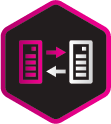
Always Be Prepared for Every Scenario
We never know when disaster will strike, but you need a business continuity plan just in case it does. AIMS Disaster Recovery services remove the unpredictability from the equation by offering end-to-end solutions that span everything from the planning process to the actual recovery, ensuring that your business stays on track come what may.
Comprehensive Disaster Recovery Solutions
AIMS offers a full spectrum of disaster recovery plans designed to address every potential risk and ensure your business stays resilient, no matter the challenge. From planning and recovery to data protection and workspace solutions, we’ve got you covered.

Recovery Consultancy and Planning Services
Expert help with consultation and planning to minimise the impact of any loss of your virtual business functions due to a disaster while addressing your business disaster recovery metrics: Recovery Time Objective (RTO) and Recovery Point Objective (RPO).

Disaster Recovery Management
Expert assistance with setting previously mapped-out processes such as Disaster Recovery, Business Continuity, Business Impact Analysis and more in motion when disaster strikes.

Data Centre-Disaster Recovery (DC-DR)
A solution that offers both primary and secondary co-location sites and its L2VPN inter-data centre connection to satisfy your physical disaster recovery needs in case of an emergency.

TIME Cloud Services Recovery Site
This cloud-based disaster recovery site can be deployed if the primary data centre is incapacitated, enabling your business to recover fully.

Off-site Tape Management
An automated and centralised workflow management of physical backup tapes to avoid data loss in the event of a natural or manmade disaster, providing a reliable solution for disaster restoration.

Disaster Recovery Workspace
A secure and customisable private or shared alternative workspace where key personnel can be relocated during any disruption, ensuring disaster recovery and business continuity.
Why AIMS Disaster Recovery Services?
AIMS delivers a comprehensive disaster recovery approach that combines proactive risk prevention with swift, effective responses to unexpected disruptions. We anticipate potential risks and implement preventative measures to safeguard your systems while ensuring your business can recover quickly when challenges arise.
Best Practices
We leverage decades of disaster recovery best practices and expertise to ensure that our solutions and tools can help you achieve your recovery targets.
Holistic Strategy
With highly trained engineers, tried-and-tested processes, policies, and technologies, our IT disaster recovery plan ensures that your business continues no matter what.
Flexibility and Operational Scalability
Our data protection, environment, and infrastructure recovery tools are designed to be scalable and suitable for all systems, budgets, and needs.
Business Resiliency
With professional server hosting and replication, failover services, and more, we help keep your business processes resilient against planned and unplanned downtime.
Make AIMS Your Trusted Disaster Recovery Solution
When disaster strikes, AIMS guarantees business continuity by quickly restoring your critical systems with minimal downtime, ensuring your IT operations stay up and running.
FAQs About AIMS Disaster Recovery as a Service (DRaaS)
Disaster Recovery as a Service (DRaaS) is a cloud-based service that enables businesses to back up their critical data, systems, and IT infrastructure to ensure quick recovery in the event of natural or man-made disasters.
DRaaS, like AIMS, offers businesses the flexibility to restore operations quickly without the need for expensive on-site infrastructure or maintaining an in-house IT team.
At AIMS, we offer end-to-end disaster recovery solutions, from reliable data backups and system replication to recovery strategies and tailored recovery plans designed to restore critical systems swiftly.
Additionally, our services include regular disaster recovery testing and updates to ensure that your disaster recovery plan remains effective and up-to-date, so you can confidently rely on it when needed most.
Our comprehensive services ensure your business is prepared for any disruption.
With disaster recovery preparedness, your business can benefit from:
- Data protection: Regular backups ensure your critical data is safe and can be quickly restored, keeping your systems in an operational state.
- Reputation management: Allows you to maintain service levels and customer trust by reducing the risk of service outages, ensuring your business stays reliable.
- Cost control: Minimising system downtime helps your business reduce the financial impact of lost revenue and expensive emergency fixes.
- Maintain productivity: Quick recovery allows your employees to get back to work without delays, ensuring smooth operations and reducing workflow disruptions.
Don’t wait for a disaster to strike! Contact us now to learn how to protect your business with a tailored disaster recovery plan.
When it comes to disaster recovery, understanding its two key metrics, Recovery Time Objective (RTO) and Recovery Point Objective (RPO), is crucial for managing downtime and data loss.
RTO: Refers to the maximum time allowed to restore a system after an outage, defining how quickly your business can get back up and running.
RPO: Quantifies the maximum amount of data you can afford to lose before it negatively impacts your business, determining how often you should back up your data.
Depending on your needs, AIMS can customise your disaster recovery solutions to meet your business requirements. Contact us today!
The main components of AIMS' disaster recovery plan are designed to ensure effective recovery and continuity of business operations in the event of a disruption. Here are the key elements:
- Risk Assessment and Business Impact Analysis (BIA): We conduct thorough assessments to identify potential risks and vulnerabilities that could impact business operations. The BIA evaluates the potential consequences of disruptions, helping prioritise recovery efforts.
- Recovery Objectives: Clear Recovery Time Objectives (RTOs) and Recovery Point Objectives (RPOs) are established. RTO defines the maximum acceptable downtime, while RPO indicates the maximum allowable data loss, guiding the recovery strategies.
- Backup and Data Protection: We implement comprehensive backup strategies, including regular on-site and off-site backups of critical data to ensure data integrity and minimise recovery time.
- Recovery Strategies: The plan outlines specific recovery strategies tailored to different scenarios, such as utilising hot sites, cold sites, or cloud-based solutions for efficient restoration of services.
- Communication Plan: Communication protocols are established to ensure that all stakeholders are informed during a disaster. This includes internal notifications and updates to customers and partners.
- Testing and Validation: Regular testing of the disaster recovery plan is conducted to identify weaknesses and ensure that all team members understand their roles in the recovery process.
- Documentation: Comprehensive documentation of procedures, workflows, and configurations is maintained to ensure quick reference during an incident.
- Ongoing Review and Improvement: AIMS continuously reviews and updates the disaster recovery plan to adapt to changes in technology, business processes, and emerging threats.
These components work together to create a robust disaster recovery framework that helps our clients maintain operational continuity during unexpected events.